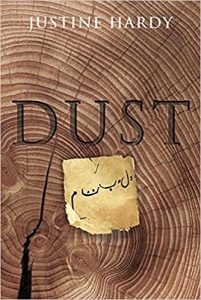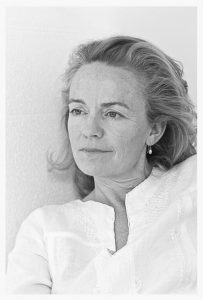Q&A With Justine Hardy: Author of DUST
 About DUST
About DUSTQuestion: How much in Dust is taken from your own experience in the aid world?
Justine Hardy: It comes of nearly forty years of watching and working for charities and NGOs, from the childlike glow of singing carols on a donkey with my sister to raise money for ‘Save the Whales,’ to being amongst nations of people on the move as refugees, leaving behind everything that they had ever known. In the face of that enormity, almost every NGO and aid worker goes through a version of the same learning curve—from believing that we can do something to change the world, to asking how much more we need to learn from people who have survived the worst atrocities and disasters.
Q: What puts you in a position to have the strong opinions that you do about mental health?
JH: There are two parts to this. The first being my fascination with what it is that enables individuals and whole peoples to survive appalling catastrophes, to learn from this capacity for adaptation so that it can be used better to support those who bruise and break mentally in the face of disaster and violence.
The second part was the hope of building an integrated and holistic mental health support system that could provide free treatment and accompaniment to people who are living in on-going conflict and disaster situations. The aim of this support system is driven by two main threads: to challenge the depersonalization of the ‘numbers game’ of almost all global mental health solutions, particularly the reliance on psychiatric medication as a ‘fix all’ with the risk of side-effects and withdrawal that can be more damaging than the original symptoms.
The other is the engagement with local and community social support systems that had been lost or destroyed along the way, systems such as how women used to meet to do their laundry together beside rivers, lakes and streams in many traditional South Asian societies. In the places that I have worked, most of these laundering places have been shut down to stop women being exposed to the risks of attack. This is not to romanticize a tough and hard labour tradition, nor is it to pretend that these women can now access washing machines, or even just a reliable power source to run them.
It is about revitalizing what came out of those laundering gatherings. In losing these washing places the women lost the time together to discuss problems at home, a grapevine that meant they could watch out for each other in the face of domestic and child abuse, they could bicker, disagree and then work out their differences, they could support and comfort each other. It is these kinds of working community gatherings that cut through the isolation and struggles at home for so many, difficulties that lost their outlets because of catastrophe and began to manifest across a wide range of depressive and anxiety issues.
Q: What do you hope readers will take away from the book?
JH: That they have been part of a story that has taken them right into the life of two very different worlds: one that seems safe in the ease of English country life, the other a place regarded as a ‘hardship posting’ with a high risk to life. I hope the reader will be drawn into these two worlds and into each setting and situation from the different points of view of the characters – to the extent that they will recognize aspects of themselves in the various characters, sometimes resonating, sometimes disagreeing, and finding themselves asking the same questions that the characters raise about international aid, race, inequality, and survival.
For everyone witnessing the current situation in Afghanistan, as refugees flee the Taliban again, I hope it will give them another view on what is being faced by those escaping and those who have to find ways to live under the Taliban again.
Q: Which came more easily to you, the Pakistani scenes in the books or the English ones?
JH: Both are places that have been landscapes that I have lived and worked in. I grew up in the English countryside, and most of my adult life has been spent in South Asia, mainly in the Kashmir Valley, on the Indian side of the volatile and unresolved India-Pakistan border. The period of English country life in Dust is the one that I grew up in at a time when older farming systems were
still being updated and replaced, and many were mourning the loss of English country life as they had known it. In contrast the setting in Pakistan is still a place of small holdings scratched out of the sides of the mountains, a place of that for many is still about subsistence survival.
Q: How did you develop your characters? And which of them do you have the strongest connection to?
JH: When anyone is working with and within other cultures, the capacity to adapt is heightened, partly from that primal survival drive to fit in and, more subtly, to understand more fully when judgements need more perspective. It can be as basic as learning to interpret body language in a different setting or, as complicated as the misunderstandings around something as sensitive as family honour. Each of the characters in Dust brings their backstory to the narrative, giving context to their actions and reactions.
I hope this also allows the reader into their different points of view so they can find out which are those they resonate with, like, dislike, those they understand and agree or don’t agree with. Every part of them comes of the people I have had the chance to live and work with, whether it is Maya, the cook’s young daughter, trying to find family structures within the curious mix of people that she is living with, or the long-distance freight driver’s risk-taking to keep to the delivery schedules that his salary and family depend on.
ABOUT THE AUTHOR
 As an author and trauma therapist, Justine Hardy writes, practices and teaches in the UK, the US, and in South Asia. She has been working in India for thirty years. It was here that she founded and ran a mental health organization in the troubled and contentious region of the Kashmir Valley in North India. She continues to work with the team as they provide free treatment, support and on-going recovery care. Justine has reported for publications ranging from the Financial Times to The Times of India. She is the author of six award winning and best-selling books, three of which have been serialized on BBC radio 4. She is a fellow of The Institute of Global Leadership at Tufts University near Boston, and she is a frequent speaker at conferences, seminars, on the radio and on television.
As an author and trauma therapist, Justine Hardy writes, practices and teaches in the UK, the US, and in South Asia. She has been working in India for thirty years. It was here that she founded and ran a mental health organization in the troubled and contentious region of the Kashmir Valley in North India. She continues to work with the team as they provide free treatment, support and on-going recovery care. Justine has reported for publications ranging from the Financial Times to The Times of India. She is the author of six award winning and best-selling books, three of which have been serialized on BBC radio 4. She is a fellow of The Institute of Global Leadership at Tufts University near Boston, and she is a frequent speaker at conferences, seminars, on the radio and on television.
Learn more about DUST by visiting http://www.justinehardy.com/
Category: Contemporary Women Writers, Interviews, On Writing
























